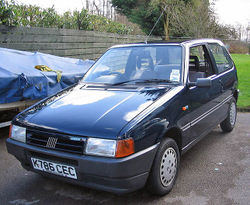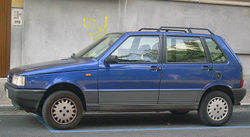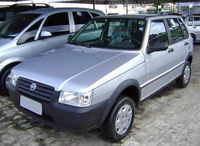Fiat Uno
| original Fiat Uno | |
| Fiat Uno | |
|---|---|
| Manufacturer: | Fiat |
| Production: | 1983—present |
| Layout & Class: | FF supermini |
| Body Styles: | 3 and 5-door hatchback sedan station wagon |
| Predecessor: | Fiat 127 |
| Successor: | Fiat Punto |
| revamped 1990 Fiat Uno | |
The Fiat Uno is a supermini car produced by the Italian manufacturer Fiat. The Uno was launched in 1983 and built in its homeland until 1995, with production still taking place in other countries.
Uno Mark I (1983–89)
The Uno was launched to replace the ageing Fiat 127. Designed by Giorgetto Giugiaro's ItalDesign company, its tall, square body utilising a Kamm tail achieved a low drag coefficient of 0.34 won it much praise for airy interior space and fuel economy. It incorporated many packaging lessons learnt from Giugiaro's 1978 Lancia Megagamma concept car (the first modern people carrier / MPV / mini-van) but miniaturised. Its tall car / high seating packaging is imitated by every small car today. It reversed the trend for lower and lower built cars. It showed that not just low sleek cars could be aerodynamic, but small, roomy, boxy well packaged cars could be too. It was voted European Car of the Year in 1984.
Initially, the Uno was offered with the 0.9 litre (903 cc) OHV, 1.1 litre (1116 cc), and 1.3 litre (1301 cc) 138-series SOHC petrol engines. The 1.3 (1300 cc) diesel (not for the UK market) engine was launched a couple of months later. The Uno's badging was not by the commonly used measurement of engine size but by bhp: 45, 55, 60, 75 or 90. The Uno was available as either a 3 or 5-door hatchback. It also featured ergonomic "pod" switchgear clusters each side of the main instrument binnacle, (that could be operated without removing the driver's hands from the steering wheel), although indicators remained on a stalk; an unusual arrangement similar to that used by Citroen.
The Uno had MacPherson strut independent front suspension and twist-beam rear suspension with telescopic dampers and coil springs, similar to that pioneered by the Volkswagen Golf. This gave good roadholding and handling, but the ride quality was not as good as rival cars like the Peugeot 205 with all round fully independent suspensions.
From 1985, the 1.0 litre (999 cc) SOHC Fully Integrated Robotised Engine (FIRE) powerplant was offered. This was a lighter engine, built with fewer parts, and gave improved performance and economy. Also in 1985, the hot hatch version - Uno Turbo - was launched, with an IHI turbocharged Ritmo/Strada-derived 1.3 146-series engine, initially offering 105 bhp. It was priced to compete with the Peugeot 205 GTI.
In 1987, a 1.7 litre diesel engined version - the 60DS -was launched. It was no more economical or faster than the 1.0L FIRE engined models but was far noisier, and the extra weight upset the cars handling. It was more popular in continental Europe than in the UK, due to diesel being substantially less taxed there, than in the UK. It was outclassed by the XUD powered Peugeot 205 diesel.
Also in 1987, the Uno Selecta continuously variable transmission (CVT) automatic was launched. The CVT transmission was a co-development with Dutch Van Doorne and Ford, (Fiat owned 24% stake of Van Doorne at that time). Unfortunately it was not very durable.
Uno Mark II (1989–95)
In September 1989, the Uno was given a major facelift, which saw updated bodywork at the nose and a different tailgate, that improved the drag coefficient to Cd 0.30, and matched the corporate look of the then new Fiat Tipo. The interior was also revised. The pod switchgear was replaced by stalks and an effort was made to stop the dashboard rattles of the Mark I. At this time, the old 1.1 litre engine was replaced by a new FIRE version, and a new Fiat Tipo-derived 1.4 litre engine replaced the Ritmo/Strada-derived 1.3 litre in both naturally aspirated and turbo versions. The Uno Turbo i.e. variant was also restyled, upgraded with a Garret T2 turbine, Bosch LH Jetronic fuel injection and better aerodynamics.
Uno production ceased in Italy in 1995, with sales throughout Western Europe stopping at the same time. A total of 6,032,911 units were built in Fiat's Italian factories. The Uno's replacement in Western Europe was the Fiat Punto, which was launched in early 1994.
Engines (Mark I and Mark II)
Petrol
| Engine | Layout | Displacement | Valves | Power | Torque | Production |
|---|---|---|---|---|---|---|
| 1.0 45 Formula | I4 | 903 cc | 8 OHV | 45 PS @ 5600 rpm | 67 Nm @ 3000 rpm | 1984–1988 |
| 1.1 55 | I4 | 1188 cc | 8 SOHC | 55 PS @ 5600 rpm | 86 Nm @ 2900 rpm | 1984–1985 |
| 1.3 70 S/SX | I4 | 1301 cc | 8 SOHC | 68 PS @ 5700 rpm | 100 Nm @ 2900 rpm | 1984–1985 |
| 1.1 60 S/Family | I4 | 1188 cc | 8 SOHC | 58 PS @ 5700 rpm | 87 Nm @ 3000 rpm | 1985–1990 |
| 1.0 45 Fire | I4 | 999 cc | 8 SOHC | 45 PS @ 5000 rpm | 80 Nm @ 2750 rpm | 1985–1990 |
| 1.1 60 SX | I4 | 1108 cc | 8 SOHC | 57 PS @ 5500 rpm | 89 Nm @ 3000 rpm | 1985-1990 |
| 1.3 Turbo i.e. | I4 | 1301 cc | 8 SOHC | 105 PS @5750 rpm | 146 Nm @ 3200 rpm | 1985-1991 |
| 1.3 70 SX/SL | I4 | 1301 cc | 8 SOHC | 65 PS @ 5600 rpm | 100 Nm @ 3000 rpm | 1985–1990 |
| 1.0 45 i.e./i.e. Start | I4 | 999 cc | 8 SOHC | 45 PS @ 5250 rpm | 74 Nm @ 3250 rpm | 1990–1994 |
| 1.4 70 SX i.e. | I4 | 1372 cc | 8 SOHC | 70 PS @ 6000 rpm | 106 Nm @ 3000 rpm | 1990-1993 |
| 1.5 75 S i.e. CAT | I4 | 1498 cc | 8 SOHC | 75 PS @ 5500 rpm | 125 Nm @ 2800 rpm | 1987-1993 |
| 1.1 50 i.e. | I4 | 1108 cc | 8 SOHC | 50 PS @ 5250 rpm | 84 Nm @ 3000 rpm | 1991-1994 |
| 1.4 Turbo i.e. | I4 | 1372 cc | 8 SOHC | 118 PS @ 6000 rpm | 161 Nm @ 3500 rpm | 1991-1994 |
Diesel
| Engine | Layout | Displacement | Valves | Power | Torque | Production |
|---|---|---|---|---|---|---|
| 1.3D | I4 | 1301 cc | 8 SOHC | 45 PS @ 4200 rpm | 112 Nm @ 2000 rpm | 1983-1989 |
| 1.4 TD | I4 | 1367 cc | 8 SOHC | 72 PS @ 4800 rpm | 128 Nm @ 2500 rpm | 1986-1995 |
| 1.7 60D | I4 | 1697 cc | 8 SOHC | 58 PS @ 4600 rpm | 100 Nm@ 2900 rpm | 1986-1995 |
Continuing global production: 1995–present
After Western European production and sales ceased, the Uno continued to be manufactured and sold in many other regions.
South Africa
In South Africa, the Uno was assembled under licence by Nissan from 1990 until 1998 and then by Fiat from 1998 up until 2006. Unos manufactured by Nissan had the word licence underneath the Fiat badge on the rear end and models included the 1100 cc FIRE as well as the 1400cc PACER, PACER SX and TURBO. There were also a number of special editions produced including the Beat and the Rio, these also featured the 1400 engine. After Fiat re-entered South Africa in 1998 Unos were rebadged as either the 1100 Mia or 1400 Tempo. They also featured the Fiat centenary badge from that point on. By the time initial production of the Uno ended in 2006 only the 3 door Mia was available for sale. 110,000 units were produced between 1990 and 2002.
In 2007, the Fiat Uno was redesigned and it re-entered the South African new car market. The car was now marketed and distributed by Fiat themselves. The model line-up includes the Uno Way, which has a higher suspension than the regular Uno and colour-coded bumpers. It is based on the 1983-1990 design, and is powered by a 1.2-litre 4-cylinder petrol engine.
Poland
Production in Fiat's factory in Poland ran until 2002. 173,382 units were built from June 1995 to October 2002.
Brazil
The car is still sold in Brazil, where a saloon version called the Fiat Prêmio (exported also as Fiat Duna), and an estate called the Fiat Elba (exported also as Duna Weekend or Innocenti Elba) were also available.
The Brazilian Uno featured an independent, transverse leaf spring suspension at the rear, based on the tried and tested Brazilian Fiat 147 (similar to the Italian Fiat 127). The design of the hood was also unique, since the Brazilian Uno kept the spare tire located in the engine bay, like the old Fiat 147.
The Fiat Uno family, in Brazil, had a turbocharged 1.4-litre four inline sports version in the early 1990s. This car was sold as a normal production vehicle.
Currently, the car is sold as the Fiat Mille, as a budget entry-level model, and received its most recent facelift for the 2004 model year. The 2005 Brazilian range has received a Flex Fuel system, enabling the car to use ethanol or gasoline as fuel, both pure or in any proportion mixture; plus, there is a version fitted for unpaved roads called Mille Way, which includes a more resilient suspension, larger wheels and side protections. From April 1988 until 2006, up to 2,000,000 Fiat Unos were made in Brazil.
Argentina
In Argentina, the Fiat Uno was produced from March 1989 to 2000, 179,767 units were built. A specific saloon version with four doors was also produced from 1988 to 2000. Called Duna or Elba, 257,259 units of this version were built in Fiat's Córdoba plant.
Pakistan
The Fiat Uno is also assembled from Complete knock down (CKD) kits in Pakistan by Raja Motor Company. Production started in 2001 and continued until 2004 when the manufacturing plant had to be closed down. Although manufacturing of the car has ceased, stocks of CKD are still being assembled and sold at present.
India
After an abortive launch in 1996 when its CKD joint partner PAL delivered only 617 cars of the 30,000 ordered, Fiat started its venture as a 50-50 Industrial Joint Venture between Fiat Group Automobiles S. p. A. (Fiat) and Tata Motors Limited (who now own Jaguar-LandRover) in January 1997. At present the company employs about 600 employees in its Ranjangaon facility in the Pune District of Maharashtra. The Uno was initially a success in India, but then it faded badly due to poor dealer support.
Morocco
The Fiat Uno was also assembled in Morocco until 2004 by SOMACA (Société Marocaine des Constructions Automobiles), and remains a popular choice of car for "petit-taxi" use
Future
The Fiat Uno may make a comeback in a few years, as a model that would sit in between the new 500 and the Punto. If this proceeds, it is to be built on a shortened version of a Punto platform and therefore would be lighter. It will compete with the likes of Citroen C2, Toyota Yaris, Ford Fiesta and Peugeot 206 as the 500 competes with Citroen C1, Toyota Aygo, Ford Ka and Peugeot 107.
Sales performance
United Kingdom
The Uno was quite popular in Britain, with 190,000 Mark I examples sold between 1983 and 1989, but only around 5,000 are reported to be still in circulation. Because of this, the Fiat Uno was the 10th most-scrapped car on Britain's roads in 2006, according to a survey by Auto Express magazine.
New Zealand
The Uno was a surprise hit for Fiat in New Zealand as well, where a combination of low prices and well received styling saw over 1000 Unos a year moved right up until the late 1980s, with the 3000th New Zealand Uno being celebrated in December 1988. Few Unos remain on the road in 2008, however, with rust being the most common factor.
Fame and notoriety
A white Uno has been alleged to have been involved in the death of Diana, Princess of Wales, on August 31, 1997. However, the car and its driver have never been traced.
Stolen Fiat Unos were used by the infamous 'Uno Bianca' gang in Italy in the early 1990s; they were easy to steal, as most of them lacked an immobilizer, and being a very common model it was easier to get away after committing robberies.
External links
| <- Older Models | Fiat car timeline, European market, 1980s - present | |||||||||||||||||||||||||||||||||||||||
| Type | 1980s | 1990s | 2000s | 2010s | ||||||||||||||||||||||||||||||||||||
| 0 | 1 | 2 | 3 | 4 | 5 | 6 | 7 | 8 | 9 | 0 | 1 | 2 | 3 | 4 | 5 | 6 | 7 | 8 | 9 | 0 | 1 | 2 | 3 | 4 | 5 | 6 | 7 | 8 | 9 | 0 | 1 | 2 | 3 | 4 | 5 | |||||
| City cars | 126 | Cinquecento | Seicento (1998-2005) / 600 (2005-2010) | |||||||||||||||||||||||||||||||||||||
| 500 | ||||||||||||||||||||||||||||||||||||||||
| Panda I | Panda II | |||||||||||||||||||||||||||||||||||||||
| Supermini | 127 | Uno | Punto I | Punto II | ||||||||||||||||||||||||||||||||||||
| Grande Punto | Punto Evo | |||||||||||||||||||||||||||||||||||||||
| Small family car |
Ritmo | Tipo | Bravo / Brava | Stilo | Bravo II | |||||||||||||||||||||||||||||||||||
| 131 | Regata | Tempra | Marea | Linea | ||||||||||||||||||||||||||||||||||||
| Albea | ||||||||||||||||||||||||||||||||||||||||
| Large family car | 132 | Argenta | Croma I | Croma II | ||||||||||||||||||||||||||||||||||||
| Coupé | Coupé | |||||||||||||||||||||||||||||||||||||||
| Roadster | 124 Spider | Barchetta | Barchetta | |||||||||||||||||||||||||||||||||||||
| Sports car | X1/9 | |||||||||||||||||||||||||||||||||||||||
| Panel van/Leisure activity vehicle | Fiorino I | Fiorino II | Fiorino III | |||||||||||||||||||||||||||||||||||||
| Doblò | ||||||||||||||||||||||||||||||||||||||||
| Mini SUV | Sedici | |||||||||||||||||||||||||||||||||||||||
| Mini MPV | Idea | |||||||||||||||||||||||||||||||||||||||
| Compact MPV | Multipla | |||||||||||||||||||||||||||||||||||||||
| Large MPV | Ulysse I | Ulysse II | ||||||||||||||||||||||||||||||||||||||
| Van | Daily* | Scudo I | Scudo II | |||||||||||||||||||||||||||||||||||||
| Ducato I | Ducato II | Ducato III | ||||||||||||||||||||||||||||||||||||||
| Mini Pickup | Strada | |||||||||||||||||||||||||||||||||||||||
| Off-road | Campagnola (1107) | |||||||||||||||||||||||||||||||||||||||
| *Rebadged Iveco model | ||||||||||||||||||||||||||||||||||||||||


